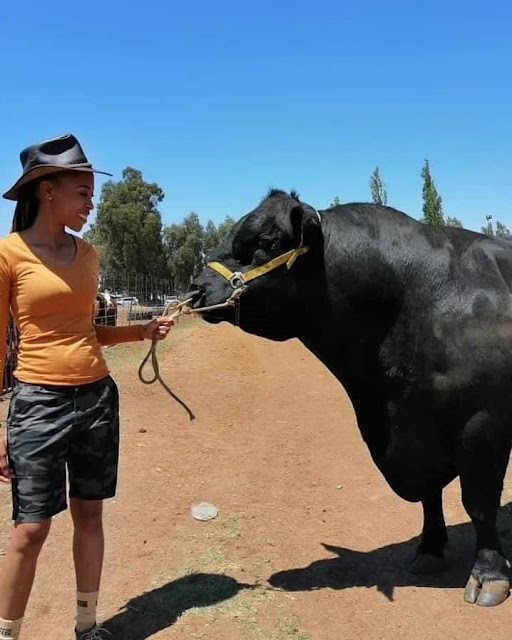Dr. Obakeng Mfikwe, the founder of Lekatu Simbras & Simmentalers stud, hung up his stethoscope in 2010 to establish a successful commercial mixed-farming operation in Lichtenburg and Magaliesburg, under the name of KMF Farm Holdings.
Lekatu Simbras & Simmentalers has won numerous awards and has
dominated shows across the country. Owner Obakeng Mfikwe, a medical doctor who
took early retirement, believes that by setting big goals you might miss them –
but if you don’t set them, it is almost guaranteed you won’t reach them.
Things took an unexpected turn for Obakeng when Rothman passed away
in a car accident in December 2008. “Dad didn’t take it so well, so I had to
fill my brother’s shoes and joined my dad on the farm,” recalls Obakeng. He
bought his first four Simbra cows in 2009. A few months later he bought another
55 Simbra stud cows, which he registered with the breed society. “I named the
stud after my dad – Lekatu was his childhood nickname,” he explains.
As part of his fodder plan, Obakeng plants about 32ha Sorom stooling
rye under irrigation for winter on his farm in Lichtenburg. The cattle graze it
for two hours a day, which provides them with enough protein to see them
through the following few days on dry grass.
As the herd grew, Obakeng needed more land. In 2011 he applied for a
farm he had identified in Lichtenburg in the heart of the maize triangle, 69km
outside Mahikeng. The 466ha farm Rietfontein was allocated to him under a
30-year lease in December 2011.
By the end of 2012, the farm was making a profit, producing maize on
more than 150ha, with 150, 000 broilers per cycle and the 160-strong Simbra
stud. Obakeng’s knowledge of cattle breeding had also grown exponentially as he
studied and attended various courses, including qualifying as a junior cattle
judge.
Last year Obakeng introduced a Black Angus stud on the farm as part
of his plans for an integrated beef value chain that could access the lucrative
niche market for certified Angus beef. “Besides its high fertility, the Black
Angus is one of the best performers in the feedlot,” he says.
Rietfontein produces 172, 000 chickens per cycle. The broiler
production plays an important role on the farm: Besides providing a good cash
flow, the litter is valuable as cattle feed and fertiliser.
“I want broad and longer animals that carry more meat. Other traits
I don’t compromise on are good mothering abilities and milk production.” He
maintains calves should not wean at anything less than 240kg. “About 15% of our
animals wean calves of between 270kg and 290kg,” he says. These animals are
selected as core breeding animals.
“As cattle farmers, especially stud breeders, we often focus on
bulls and neglect the cows, forgetting that they’re equally as important,” he
points out.
Obakeng says he is no longer as concerned with adding numbers to the
herd as with having superior genes. “My cows have to produce the heaviest
calves that are long and broad with sound conformation. Cows must produce
enough milk and have exceptional mothering abilities,” he stresses. Admittedly,
such exceptional quality is not yet as widespread as he would have liked.
Obakeng runs a small feedlot that he intends to move to his new farm
in Magaliesburg, where the capacity will exceed 20, 000 animals.
All his camps have enough clean water. “Animals should not have to
walk far from where they are grazing to find water, as they tend to lose
condition,” Obakeng adds.
Obakeng believes your reputation is everything when you’re a young
black stud farmer, and superior genetics is the name of the game.
Obakeng produces 70% maize and 30% sunflower on a combined 1, 152ha
(952ha in Lichtenburg and 200ha in Magaliesburg).






Comments
Post a Comment